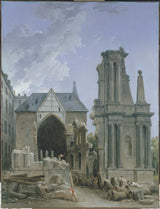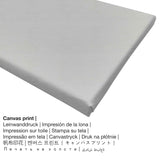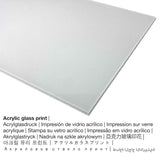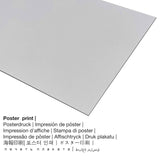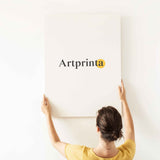Hubert Robert, 1804 - Nbibi nke ụka na Feuillant - mbipụta nka mara mma
Ụtụ gụnyere. Mbupu gbakọrọ na ndenye ọpụpụ.
Akụrụngwa ndị ahịa anyị nwere ike ịhọrọ
Anyị na-enye ihe dị iche iche dị iche iche na nha maka ngwaahịa ọ bụla. Họrọ nha na ihe kacha amasị gị n'ime nhọrọ ndị a:
- Glass acrylic e biri ebi (nwere ezigbo mkpuchi iko): The acrylic glass print, often labelled as a fine art print on plexiglass, transforms the original into beautiful décor. Moreover, it forms a distinct alternative option to dibond and canvas art prints. With an acrylic glass fine art print contrasts as well as granular artwork details will be exposed with the help of the very subtle tonal gradation of the picture.
- Mbipụta kanvas: A canvas direct print is a printed cotton canvas mounted on a wooden frame. How do I hang a canvas on my wall? A canvas print has the great advantage of being low in weight. This means, it is easy and straightforward to hang your Canvas print without the support of extra wall-mounts. Hence, a canvas print is suitable for any kind of wall.
- Poster (akwa akwa akwa): A poster print is a UV printed flat canvas paper with a fine finish on the surface, which resembles the actual version of the artwork. Please note, that depending on the absolute size of the canvas poster print we add a white margin of something between 2-6cm around the print, which facilitates the framing with a custom frame.
- Aluminom dibond mbipụta (ọla): An Aluminium Dibond print is a print with an impressive effect of depth. A direct Aluminium Dibond Print is the ideal introduction to art prints manufactured with aluminum. For the Direct Print On Aluminum Dibond, we print your chosen artwork on the aluminium white-primed surface. The white & bright parts of the original artwork shimmer with a silky gloss, however without the glare. Colors are bright and vivid in the highest definition, fine details of the print appear very clear.
Ozi dị mkpa: We try everythig possible in order to depict our art products in as much detail as possible and to showcase them visually. Please bear in mind that the pigments of the printed materials, as well as the imprint might diverge slightly from the representation on the device's screen. Depending on your screen settings and the condition of the surface, colors might not be printed 100% realistically. Since all art prints are printed and processed by hand, there might also be minor variations in the motif's size and exact position.
Nkọwapụta nka sitere na weebụsaịtị Musée Carnavalet Paris (© - Musée Carnavalet Paris - www.carnavalet.paris.fr)
The Church of the Feuillants demolition rue Saint-Honoré, 8th district. Architecture. Works. Ruins. Rubble. Cart.
The convent of the Feuillants order affiliated with the Cistercians, was the Rue St. Honore. It closed in 1790 and became the meeting place of a famous revolutionary club, while part of the premises was occupied by the Constituent Assembly and the Convention. The church, designed by architect François Mansart, disappeared during the construction of the rue de Castiglione.
Ozi gbasara ngwaahịa nka a
Na 1804 na nwoke onye na-ese ihe Hubert Robert made this rococo masterpiece called "The church demolition in Feuillant". The original was painted with the size: Height: 160 cm, Width: 128 cm, Depth: 6 cm. Besides, the artpiece is part of the digital art collection of Ụlọ ihe nkiri Carnavalet Paris, which is a museum dedicated to the history of the city Paris. We are happy to mention that this artpiece, which is part of the ngalaba ọha gụnyere - n'ikike nke Ụlọ ihe nkiri Carnavalet Paris.: . N'elu nke ahụ, nhazi bụ Eserese na a akụkụ ruru nke 3: 4, nke pụtara na ogologo bụ 25% mkpụmkpụ karịa obosara. The curator, painter Hubert Robert was an artist, whose art style was mainly Rococo. The Rococo artist lived for 75 afọ - amuru na 1733 na Paris, Ile-de-France, France na nwuru anwu na 1808.
Ozi ọrụ nka
| Aha nka nka: | "The church demolition in Feuillant" |
| Nhazi nke ihe nka: | sere |
| Otu izugbe: | nkà nke oge a |
| oge: | 19th narị afọ |
| Emepụtara na: | 1804 |
| Ogologo afọ nka nka: | 210 afọ |
| Akụkụ ihe osise izizi: | Ogologo: 160 cm, obosara: 128 cm, Omimi: 6 cm |
| Ụlọ ihe ngosi nka: | Ụlọ ihe nkiri Carnavalet Paris |
| Ebe ebe ngosi nka: | Paris, France |
| ibe weebụ: | Ụlọ ihe nkiri Carnavalet Paris |
| Ụdị ikike nka: | ngalaba ọha |
| Site n'aka: | Ụlọ ihe nkiri Carnavalet Paris |
Ozi ihe ahaziri ahazi
| Nkewa edemede: | nka nka |
| Mmeputakwa: | mmeputakwa n'ụdị dijitalụ |
| Usoro mmepụta: | mbipụta dijitalụ |
| Mmalite ngwaahịa: | German mmepụta |
| Stockdị ngwaahịa: | a na-achọ |
| Ojiji ngwaahịa: | mkpokọta nka (mmeputakwa), mgbidi gallery |
| Nhazi nka nka: | usoro eserese |
| Ụdị anya: | 3: 4 |
| Nkọwa nke oke akụkụ: | ogologo bụ 25% mkpụmkpụ karịa obosara |
| Nhọrọ ihe dị: | mbipụta akwụkwọ mmado (akwụkwọ kwaaji), mbipụta kanvas, mbipụta enyo acrylic (nwere ezigbo mkpuchi iko), mbipụta ọla (aluminium dibbond) |
| Nhọrọ nke Canvas Mbipụta (akwa akwa na etiti ihe ndọtị): | 30x40cm - 12x16", 60x80cm - 24x31", 90x120cm - 35x47", 120x160cm - 47x63" |
| Mbipụta iko acrylic (nke nwere ezigbo mkpuchi iko): | 30x40cm - 12x16", 60x80cm - 24x31", 90x120cm - 35x47", 120x160cm - 47x63" |
| Nhọrọ nha nke akwụkwọ mmado (akwụkwọ kwaaji): | 30x40cm - 12x16", 60x80cm - 24x31", 90x120cm - 35x47" |
| Nhọrọ nha nha nke aluminom dibond (ihe aluminom): | 30x40cm - 12x16", 60x80cm - 24x31", 90x120cm - 35x47" |
| Nhazi nke nka nka: | enweghị etiti |
Tebụl nchịkọta ihe nkiri
| aha: | Hubert Robert |
| Aha ndị ọzọ: | Robert des Ruines, Robert Hubert des Ruines, Robert Hubert, Hubert Robert, Roberts Hubert, Robarts Hubert, Robart Hubert |
| okike onye nka: | nwoke |
| Nationality: | French |
| Ọrụ: | curator, onye na-ese ihe |
| Mba onye si: | France |
| Otu nka: | omenkà nke oge a |
| Ụdị nka: | Rococo |
| Ndụ: | 75 afọ |
| Amụrụ n'afọ: | 1733 |
| Amụrụ na (ebe): | Paris, Ile-de-France, France |
| Afọ ọnwụ: | 1808 |
| Nwuru na (ebe): | Paris, Ile-de-France, France |
Enwere ikike nwebiisinka ©, Artprinta.com (Artprinta)

